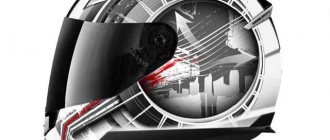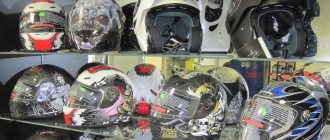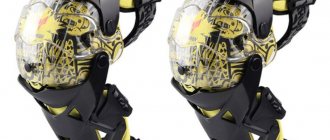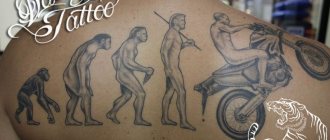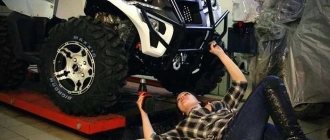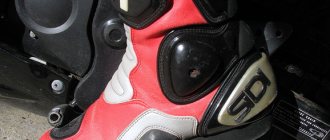1.Do not take into account the purpose and nature of the ride
All motorcycle helmets are divided into types, each of which is good in its own way. Before choosing a helmet, you need to decide where and how you will use it? What is your main purpose for riding a motorcycle?
The required characteristics of a motorcycle helmet depend on the answers. It often happens that a motorcyclist really likes one helmet, but needs a completely different one. Still, the most important thing in a helmet is not design, but reliability, comfort and functionality.
“What can each motorcycle class teach?”
Components of a motorcycle helmet
Any helmet consists of several protective layers located one on top of the other. This is dictated by the requirements of safety and ease of use.
The outer layer is the strongest type of plastic or other material that must withstand direct impact. Currently, impact-resistant plastic is being replaced by carbon and carbon fiber, which have shockproof characteristics.
The second layer is foam, which absorbs impact forces and protects the rider's head. It is very important that the filler is of high quality, because safety in the event of an unexpected fall or accident depends on it.
The third, inner layer is designed to provide comfort. Often presented with a removable part for cleaning and washing. It allows the skin to breathe and stays in the helmet for a long time.
You can purchase a motorcycle helmet in our online store. The product range includes a variety of products designed for different types of use. All presented products are certified and meet the stated safety requirements. The company's qualified specialists will answer all your questions and help you make the right choice in favor of one model or another.
Use one helmet for all occasions
It’s not for nothing that helmets are divided into types. Even the most versatile helmet cannot be the best in any one discipline or be equally good in summer and winter. If you ride all year round (not just in the city), then you may need another helmet.
Yes, there are universal models that perform well in the city and while traveling, but you must agree that a specialized helmet will perform better. Therefore, if you are a very active motorcyclist, you may need another motorcycle helmet - for motorcycle racing, cross-country, touring - for roads where a simple city helmet will not be enough.
“Motorcycle helmets - what are they and which one to choose?”
How should a motorcycle helmet fit?
When trying on a helmet, you need to pay attention to the following details:
- The helmet should fit and fit snugly, but there should be no pain, squeezing or any other discomfort. Otherwise, you will be constantly distracted by it and not watch the road. If you choose a small size, compression of the brain vessels may occur, which will cause constant dizziness.
- The top of the helmet should be in contact with the crown of your head.
- The fastened strap should not squeeze your throat.
- When the strap is fastened, the helmet should not move, i.e. even if you pull it strongly, with both hands, up or to the sides, it should not give in; more precisely, there should be a feeling that the skin is stretching along with the helmet.
- Without unfastening the strap, you need to try to pull the helmet off yourself, and you need to do this quite actively, helping with your fingers, muscles and wriggling in every possible way. If the result is unsatisfactory, then the size is chosen correctly.
- If, when you press on the back of the helmet, you can stick your finger between the forehead and the helmet, then this model is large.
- The helmet should not block the view, incl. to the sides and when moving the head. That is, all objects must be visible clearly and clearly.
Once a comfortable copy has been found, you need to spend 10 to 30 minutes in it to understand how a motorcycle helmet should sit on your head. Ideally, if the store provides the opportunity for a test drive, in which case you will be able to evaluate the noise level during driving time, quality of ventilation, real view of the road and a number of other parameters. In general, the main indicator of the right choice is “forgetting” that you are wearing a helmet, so much so that it becomes an organic extension of your head.
4.Buy a helmet from a friend
A helmet is a personal protective equipment. Each motorcyclist chooses a helmet according to his anatomical features and preferences. A friend chose a helmet for themselves, so you choose a helmet that suits you.
When you try on another person’s helmet, you don’t think that the lining has changed the shape of the owner’s head during wear, and when you order a new one, you are surprised at how tightly the helmet fits.
“How not to choose equipment?”
5.Order without measurements
The shape of a person's head can be different - a long oval, a round or an intermediate oval. Therefore, helmet sizes will feel and fit differently for different head shapes. Helmet manufacturers always offer size charts so that the motorcyclist can choose his size correctly and accurately.
It's like buying shoes. You know your foot size, but you still check it every time depending on the model. Why is everyone afraid to order shoes online?
“Well, I should walk around in it, in case it rubs or doesn’t fit,” someone will say.
Why is a helmet worse? He actually protects his head! It is foolish to choose a size without checking it according to the chart. Different brands may have differences in the interpretation of size due to the design and manufacturing features of the helmet.
How to choose a motorcycle helmet size?
Beginners have a question: how to choose a helmet size?
Now I’ve decided on the model, but how can I choose the right size helmet? There is a universal table of motorcycle helmet sizes. Manufacturers suggest that you take a sewing meter and measure around the circumference a centimeter above the eyebrows, you will get a number around 60 cm. Based on this size, you can determine the size of the helmet using the table.
The match will be 70-80% (based on our sales experience of more than 5 years), but there will also be misses, because the helmet is held on the temporal part of the head and also on the cheeks.
Plus the helmets themselves come in different shapes: circle, oval, elongated helmet
. Please check these details in stores when purchasing.
Buy unknown brands
Little-known brands are often considered due to their budget. A cheap helmet from an unknown manufacturer is a game of roulette. Yes, it will cost modestly, but at best it will have only one DOT certification. Do not forget that in order to use a helmet, it is necessary to comply with the safety standards of the country in which it is worn.
If there are no reviews at all for a little-known brand, then you should refuse to purchase.
“Types of motorcycle helmet certifications - an overview of ECE, DOT, Snell, SHARP and FIM”
Road accident - always think about your own safety
Many tens of thousands of people paid with their lives for an irresponsible and disregardful attitude towards both their own and others’ lives. Many of them, having miraculously survived or become disabled, probably thought about how much could have changed if they had chosen the right motorcycle helmets. We all know information about the terrible statistics of terrible accidents on the roads of our vast homeland. So, let's not aggravate such horrific statistics. Let's think about how important it is to follow the correct driving regime and choose excellent motorcycle helmets to protect the most precious thing we have.
Dispassionate statistics claim that riders without helmets are much more likely to get into accidents than those who take care of their safety. The size of a motorcycle helmet, as well as the choice, is an extremely important and responsible matter. Therefore, from the huge variety that is so necessary for a motorist, you will need to choose the best one. Think about what is most important to you and start making a choice, and let your choice be the only right one!
Such an important part of the rules for the driver as the need to wear a motorcycle helmet is enshrined even in the traffic rules as an indispensable necessity. Police officers often fine those who do not want to obey the rules, but still this does not stop new fans of driving recklessly on the roads. Use motorcycle helmets - become stronger and wiser than those who frivolously and thoughtlessly endanger their lives!
8. Buy a cheap or used helmet for the passenger
The passenger has the right to protection, just like the motorcyclist! There are generally nothing but problems with passengers. Give them equipment, put them on a motorcycle so they don’t fall off...
“What do you need to know about riding a motorcycle with a passenger?”
The conflict of interest here is simple. If you decide to spontaneously let someone down, you need to provide the passenger with protection. But you won’t carry the entire store’s assortment with you in order to select at least a helmet and gloves in the right size for a random person? Therefore, motorcyclists usually carry a “duty” helmet with them. The most experienced ones have a rough idea of the average passenger head size and choose the most common one. For example, if a guy likes to ride girls, then he is unlikely to carry a 3XL size helmet with him. Although there is no arguing about tastes!
In order not to spend extra money, they often take their own outdated helmet or one that was used by someone else. But. The passenger is also at risk of serious injury, so his helmet must be safe and comfortable.
It’s good for those who are regular passengers - motor couples, parents and children. Then the equipment is purchased by the passenger himself with the expectation that he will often need to travel as number two. You wouldn’t give your child an incomprehensible used helmet, right?
Useless add-ons
Not that this was a mistake when choosing... But I think it’s necessary to pay attention. Some motorcyclists have a fashion for all sorts of “tails”, “horns”, “ears”, “Iroquois” and other oddities that do not carry any practical meaning other than the shocking appearance and relative recognition of the pilot on the road.
The fact is that when such modifications appear on a motorcycle helmet, somewhere the engineer who developed the aerodynamics of your motorcycle helmet is crying. And in the next corner another engineer is crying, who will say that if the “horns” are attached by mounting them into the helmet body, then you are thereby violating its integrity. Consequently, a helmet with a damaged shell shell is more likely to crack under a strong impact. Such a story.
If you find a way to mount without damaging the helmet, then the aerodynamics engineer will not cry any less. All these protruding parts will affect air resistance during acceleration. If it falls, such “beauty” will most likely be repulsed. It’s good if the “tail” or “horns” don’t get caught on anything, scraping sparks on the asphalt.
This is not a shame for motorcyclists who use such decorations. I don't want to offend anyone. Decorating a helmet is a personal matter for everyone. There are simply more logical and less traumatic ways to do this - a color visor, a spoiler, airbrushing as a last resort.
Types of helmets:
- Open helmets
- Integral/full-face
- Modular/flip-up
- Cross helmets
- Dual sport
Open helmets are the lightest and least protected models, which are in demand among drivers of small-sized motorcycles and scooters. Simple as five kopecks, helmets protect only the occipital, frontal and parietal parts of the head, leaving the chin and face exposed. Such models may have an additional visor and are often combined with glasses and visors. The absence of a chin makes it well ventilated, noisy and dangerous at high speeds. Such helmets interestingly complement the image of retro motorcycles and low-speed models.
The Integral is a win-win option that is ideal for any purpose other than extreme off-road driving. The closed design completely protects the rider's head. The integrity of such a helmet guarantees excellent protection in case of a fall, as it has a minimum of moving parts. The integral is also called “full face”. The obvious strengths will be sound insulation, which in closed models will be one of the best, a minimum of spare parts and good aerodynamics. Ventilation in the integral is not up to par, although manufacturers have developed a number of ventilation channels, and if necessary, the helmet must be completely removed. But there are very good offers in terms of ventilation, for example, Icon Airmada Stack.
With all this, the full face is great for beginners and experienced motorcyclists traveling in heavy city traffic. A separate bonus is the wide range of visors, the replacement of which is not difficult. For some, the presence of built-in glasses in models is a revelation; yes, there are such worthy offers, for example, Icon Alliance GT Operator!
Modular - aka “flip-up”. It can be called a tuned, pumped up integral. The essence of a helmet comes down to maximum comfort for the motorcyclist. This is actively used by lovers of long and short distance travel. In order to talk, smoke a cigarette or drink coffee at a gas station, just fold back the “cheek” of the helmet without removing it from your head. Such helmets always have many additional options, ranging from sunglasses to headsets. For increased comfort you have to pay in terms of aerodynamics, noise and extra weight. Modulars are some of the heaviest helmets you will ever see on the shelves.
Cross motorcycle helmets are highly specialized models of helmets that are designed for cross and enduro classes. These helmets are easily recognized by their reinforced chin and visor. Cross-country models do not have a visor, as they are adapted for wearing special cross-country glasses, which during training and races are often much more practical than a visor. Active driving involves intense breathing by the driver, so excellent ventilation is an undoubted huge plus of such helmets. Driving in them at high speeds is quite difficult due to the protective visor, which saves the athlete from the sun, rain, branches and dirt, but provides noticeable resistance to the headwind. Cross helmets are usually quite light, but noisy due to the open design.
Dual-sport is an upgrade to the helmet, resulting in a dual-purpose model that can be used both on public roads and off-road. These helmets are desperately loved by extreme tourists, ATV riders and snowmobile owners. The model is too heavy for professional racing, but is very comfortable for active off-piste driving. The visor and jaw extension of the helmet make breathing easier, which becomes noticeably more frequent when leaving a regular off-road route. Dual sport allows you to use many additional options, which undoubtedly increases comfort.
